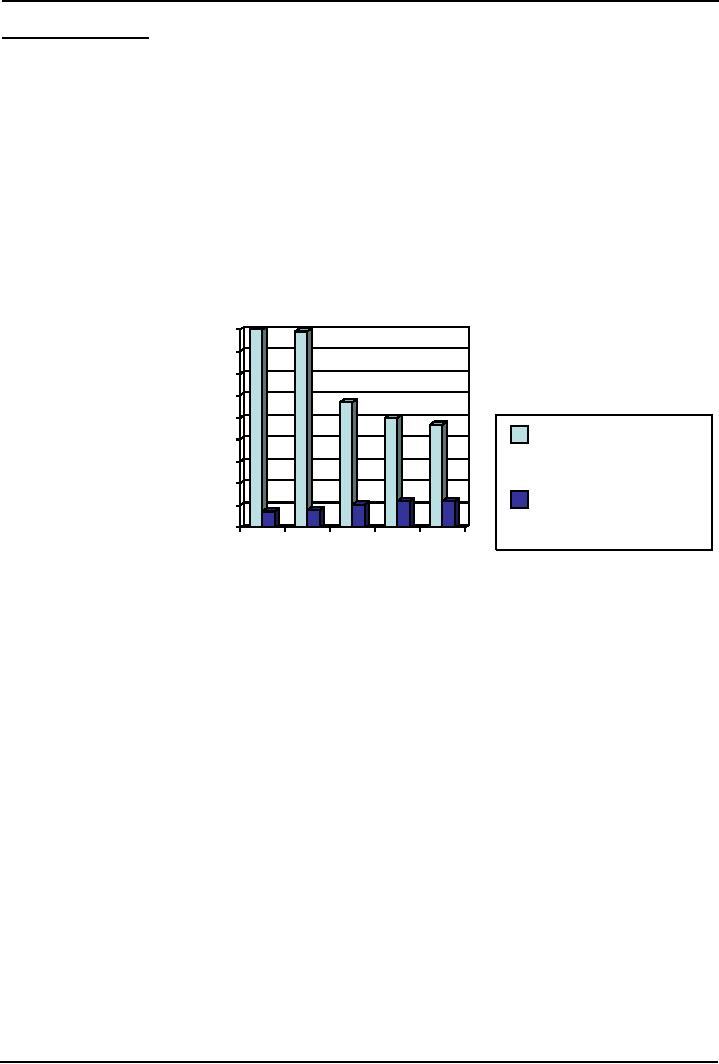 |

Social
Psychology (PSY403)
VU
Lesson
36
REDUCING
AGGRESSION
Aims
To
introduce different social and
psychological strategies to reduce
aggression.
Objectives
·
Describe
various methods to reduce aggression:
punishment, inducing incompatible
responses,
reducing
frustration, and teaching of non
aggressive responses
Introduction
Legal
systems throughout the world
use punishment to deal with
violent criminals. The most
common
treatment
is punishment; ultimate punishment is
death. Three conditions necessary
for punishment being
effective
are described below:
·
Prompt
·
Relatively
strong
·
Consistent
Relatively
effective strategies
·
Punishment
·
Inducing
incompatible responses
·
Reducing
frustration
·
Teaching
non aggressive
responses
Punishment
Is
punishment truly effective?
·
Aggressor
punisher may serve as an
aggressive model according to social
learning theory
·
That
is exactly the process underlying the
continuing cycle of family
violence (Hanson et al.,
1997)
·
Although
punishment may reduce
aggressive behavior, it does
not teach the aggressor
new
prosocial
forms of behavior
·
Fear
of punishment or retaliation reduces
aggression only in the immediate
situation.
·
Generates
anger, sparks counter-aggression:
Cognitive neo-associationist model would
suggest that
it
may even provoke intense anger in the
aggressor-turned-victim (if aggressors
are extremely
angry,
threats of punishment will
not work)
·
Even
if they worked, this is too
expensive to be a wide-spread
solution
Incompatible
response strategy
·
All
organisms are incapable of
engaging in two incompatible
responses/ emotions
·
Inducing
incompatible responses/ emotions with
anger may effectively deter
such actions (Robert
Baron,
1976)
·
Baron's
study (1976) based on Turner
et al.'s (1975) observation
that motorists honk their horns
to
express
their irritation
148

Social
Psychology (PSY403)
VU
Baron's
study (1976):
·
Instructed
a research confederate to driving a car
near campus to frustrate
other motorists by
stopping
car at a traffic light for
15 seconds
·
Two
observers noted the motorists'
frustration
·
Three
experimental conditions
o
Inducing
empathy
o
Creating
humor
o
Mild
sexual arousal
·
Two
control conditions
o
Simple
distraction
o
Being
absent from the scene
Figure
1: Aggression inhibiting influence of
incompatible responses
Reducing
frustration
90
·
Government
80
responses
to try to
70
reduce
large-scale
60
economic
frustrations
are
50
%
of honking
sometimes
40
effective,
30
sometimes
not.
20
Latency
of
10
·
Homicide
studies
honking
0
in
Pakistan
Control
Em
pathy
Sexual
(Suhail
& Javed,
arous
al
2002;
Suhail &
Khalid,
2006)
indicate
that people involved in
homicidal acts belonged to
middle social class, supposed to
have
more
social and psychological conflicts and
burdens.
·
However,
such programs can not
totally eliminate frustration, so
other techniques for
reducing
aggression
are necessary.
Teaching
non aggressive responses to
provocation
·
Social
modeling
·
Internalizing
anti-aggression beliefs
·
Apologies
as aggression controllers
·
Social
skills training
·
Reducing
exposure to violence
Social
modeling:
·
Social
learning theorists contend that non
aggressive models can urge
observers to exercise
restraint
in the face of provocation
·
Research
participants who watched a non
aggressive model exhibit
restraint in administering
shocks
to a victim were subsequently less
aggressive (Baron & Kepner,
1970)
·
Aggression
can be controlled by having an
authority figure condemning the
behavior of aggressive
individuals
149

Social
Psychology (PSY403)
VU
·
Less
imitation in child if an adult
condemns TV violence (Horton &
Santogrossi, 1978)
·
The
last two points discussed
above refer to just
condemning not
modeling.
Internalizing
anti-aggression beliefs:
·
When
people internalize certain
beliefs and attitudes into
their self-concept, they are more
likely to
act
in ways consistent with them (belief
ownership)
·
When
children were prompted to generate
reasons why it was bad to
imitate TV violence, TV
violence
had less impact on their
attitudes and behavior (Huesmann et al.,
1983)
Apologies
as aggression controllers:
Study
by Ken-ichi Ohbuchi et al.
(1989):
·
Japanese
college students were embarrassed by
their poor performance while
working on a
complex
experimental task
·
Because
the experimenter's assistant committed a
series of errors in presenting
experimental
material
to them
·
Experimenter
criticized the assistant who
then either apologized for
causing the participants to
fail,
or
said nothing
·
Participants
were asked to rate the assistant on several dimensions
which were to be used as a
basis
for
the assistant's grade
·
A
public apology significantly
reduced hostility
·
The
implications of these techniques are
that by just saying sorry
you can reduce
interpersonal
hostility.
Any
gender differences in willingness to
apologize?
·
Women
are more willing than men to
take responsibility for a
perceived social transgression
(Gonzales
at al., 1990)
·
Women
tend to be more apologetic when
severely reproached (Hodgins &
Liebeskind, 2003)
·
Men
have a fear of "losing face" or
social status in such
confrontations (Hodgins et al.,
1996)
Social
skills training:
·
The
art of apologizing is just one
skill in a large repertoire of
interpersonal skills learned
through
the
process of socializing
·
Children
of low IQ are less likely to
learn, hence have more of a combative
interpersonal style
that
invites
aggression and further
interferes with their
intellectual development
·
As
children mature, their impulsive
aggressive reactions to anger are replaced by more
socially
acceptable
aggressive responses, such as
negotiations, compromise, and cooperative
problem
solving
·
Social
skills training can take
many forms: role-playing of
non aggressive behaviors,
modeling the
prosocial
actions of others, or generating non
aggressive alternative solutions to
conflict
150

Social
Psychology (PSY403)
VU
·
In
one 12-session intervention program,
both male and female delinquents
not only showed
increased
skills in solving social problems, but
also exhibited a decrease in
their aggressive
beliefs
and
actions (Guerra & Slaby,
1990)
Reducing
exposure to violence:
Robinson
et al.'s study
(2001):
·
Third-
and fourth-grade students at 2 comparable
schools were examined over a
6-month period
·
In
one school TV and video-game exposure was
reduced by one-third by encouraging
students and
parents
to engage in alternative forms of
home entertainment
·
Intervention
school children showed less
subsequent aggression on the
playground
Reading
·
Franzoi,
S. (2003). Social
Psychology. Boston:
McGraw-Hill. Chapter 13.
Other
Readings
·
Lord,
C.G. (1997). Social
Psychology. Orlando:
Harcourt Brace and Company. Chapter
8.
·
David
G. Myers, D. G. (2002). Social
Psychology (7th ed.).
New York:
McGraw-Hill.
·
Taylor,
S.E. (2006). Social
Psychology (12th ed.). New York: Prentice
Hall.
151
Table of Contents:
- INTRODUCTION TO SOCIAL PSYCHOLOGY:Readings, Main Elements of Definitions
- INTRODUCTION TO SOCIAL PSYCHOLOGY:Social Psychology and Sociology
- CONDUCTING RESEARCH IN SOCIAL PSYCHOLOGY:Scientific Method
- CONDUCTING RESEARCH IN SOCIAL PSYCHOLOGY:Evaluate Ethics
- CONDUCTING RESEARCH IN SOCIAL PSYCHOLOGY RESEARCH PROCESS, DESIGNS AND METHODS (CONTINUED)
- CONDUCTING RESEARCH IN SOCIAL PSYCHOLOGY OBSERVATIONAL METHOD
- CONDUCTING RESEARCH IN SOCIAL PSYCHOLOGY CORRELATIONAL METHOD:
- CONDUCTING RESEARCH IN SOCIAL PSYCHOLOGY EXPERIMENTAL METHOD
- THE SELF:Meta Analysis, THE INTERNET, BRAIN-IMAGING TECHNIQUES
- THE SELF (CONTINUED):Development of Self awareness, SELF REGULATION
- THE SELF (CONTINUE…….):Journal Activity, POSSIBLE HISTORICAL EFFECTS
- THE SELF (CONTINUE……….):SELF-SCHEMAS, SELF-COMPLEXITY
- PERSON PERCEPTION:Impression Formation, Facial Expressions
- PERSON PERCEPTION (CONTINUE…..):GENDER SOCIALIZATION, Integrating Impressions
- PERSON PERCEPTION: WHEN PERSON PERCEPTION IS MOST CHALLENGING
- ATTRIBUTION:The locus of causality, Stability & Controllability
- ATTRIBUTION ERRORS:Biases in Attribution, Cultural differences
- SOCIAL COGNITION:We are categorizing creatures, Developing Schemas
- SOCIAL COGNITION (CONTINUE…….):Counterfactual Thinking, Confirmation bias
- ATTITUDES:Affective component, Behavioral component, Cognitive component
- ATTITUDE FORMATION:Classical conditioning, Subliminal conditioning
- ATTITUDE AND BEHAVIOR:Theory of planned behavior, Attitude strength
- ATTITUDE CHANGE:Factors affecting dissonance, Likeability
- ATTITUDE CHANGE (CONTINUE……….):Attitudinal Inoculation, Audience Variables
- PREJUDICE AND DISCRIMINATION:Activity on Cognitive Dissonance, Categorization
- PREJUDICE AND DISCRIMINATION (CONTINUE……….):Religion, Stereotype threat
- REDUCING PREJUDICE AND DISCRIMINATION:The contact hypothesis
- INTERPERSONAL ATTRACTION:Reasons for affiliation, Theory of Social exchange
- INTERPERSONAL ATTRACTION (CONTINUE……..):Physical attractiveness
- INTIMATE RELATIONSHIPS:Applied Social Psychology Lab
- SOCIAL INFLUENCE:Attachment styles & Friendship, SOCIAL INTERACTIONS
- SOCIAL INFLUENCE (CONTINE………):Normative influence, Informational influence
- SOCIAL INFLUENCE (CONTINUE……):Crimes of Obedience, Predictions
- AGGRESSION:Identifying Aggression, Instrumental aggression
- AGGRESSION (CONTINUE……):The Cognitive-Neo-associationist Model
- REDUCING AGGRESSION:Punishment, Incompatible response strategy
- PROSOCIAL BEHAVIOR:Types of Helping, Reciprocal helping, Norm of responsibility
- PROSOCIAL BEHAVIOR (CONTINUE………):Bystander Intervention, Diffusion of responsibility
- GROUP BEHAVIOR:Applied Social Psychology Lab, Basic Features of Groups
- GROUP BEHAVIOR (CONTINUE…………):Social Loafing, Deindividuation
- up Decision GROUP BEHAVIOR (CONTINUE……….):GroProcess, Group Polarization
- INTERPERSONAL POWER: LEADERSHIP, The Situational Perspective, Information power
- SOCIAL PSYCHOLOGY APPLIED: SOCIAL PSYCHOLOGY IN COURT
- SOCIAL PSYCHOLOGY APPLIED: SOCIAL PSYCHOLOGY IN CLINIC
- FINAL REVIEW:Social Psychology and related fields, History, Social cognition